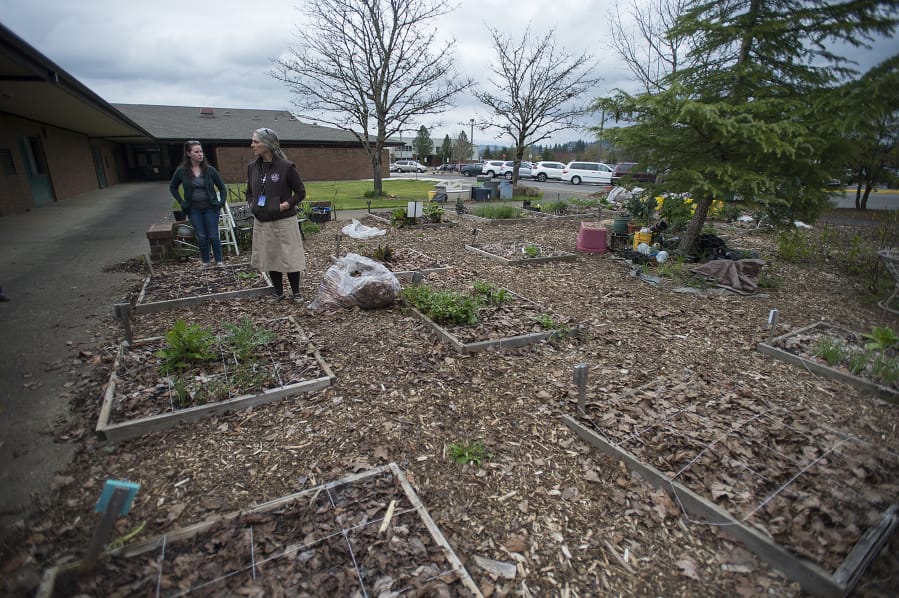When River HomeLink, an alternative school in Battle Ground, got a grant to turn part of a lawn into an outdoor learning area, Kris Potter, the school’s garden coordinator, recalled how the project could have turned into a big muddy mess. So the school called the Clark Conservation District for help.
Staff from the district came out and examined the soil and drainage. After finding out what would be best to plant there, they helped get rid of the grass and installed native plants such as dogwoods, Oregon grape, Indian plum and others. Now, the area has a vegetable garden, a bioswale to help drain runoff and a hedge of native plants that will provide a buffer from a busy nearby street.
Potter said that students now use the area to replicate pioneer gardens, study bees and toads or just have a quiet place for art class.
“The kids love the space,” said Potter. “It’s like having a field trip in our front yard.”
But a new county report finds that while Clark County benefits from the free technical assistance and land management services provided by the district, the agency will go bust by the end of the year unless its funding structure is changed.
The report, obtained by The Columbian, was produced by a work group of county staff assembled by Interim County Manager Jim Rumpeltes after the Clark County Council declined to approve new fees to sustain the district in December. With exception of Council Chair Marc Boldt, members of the council said they appreciated the district’s work but were reluctant to saddle taxpayers with another expense.
The district was formed in 1942 during the Dust Bowl era to help farmers conserve soil. Since then, it’s expanded its reach, helping landowners get grants, comply with environmental regulations or install environmental features on their land, such as bioswales or vegetative buffers.
In recent years, the grants that have made up much of the district’s budget have declined. Last year, the district unsuccessfully approached the county council asking it to approve new fees of $5 per parcel of land and 10 cents per acre. Without the tax revenue, the district would be forced to close, it said.
The county’s report confirms that prediction.
“Without a new funding source, it is likely the district will not be financially viable by the end of 2018,” reads the report.
The report notes that the district is funded entirely by state and federal grants. Reliance on this funding mechanism creates instability in its programming and makes it harder to address environmental projects that can take multiple years to complete, according to the report.
The district has an annual budget of approximately $368,000 and typically has a staff of three, according to the report. By the end of the year, the district will have a fund balance of $40,000 and will “cease to exist as a freestanding district.”
Manager Denise Smee stepped down last week for a new job. Zorah Oppenheimer, resource technician for the district, said that despite the dire financial forecast, the report highlights many positives.
“It’s an internal report from the county saying we provide a public benefit and we are good with our money,” said Oppenheimer.
The report states that the district is well-managed and has received good marks from the State Auditor’s Office. The report also concluded that in addition to the direct benefits the district provides to landowners, it also provides indirect benefits that provide more value to the county than the overall cost of the grants.
Oppenheimer said the report makes a strong case for the county council to establish the requested fees. The report states that a $5 fee will generate approximately $774,000 and allow the district to hire another staff member.
According to the report, a fee of more than $4 is needed to maintain current staffing levels. The report suggests aligning it with county priorities on farmland preservation, watershed restoration and fish passage. Oppenheimer said the district is open to collaboration but noted that fish passage projects get expensive.
The report presents alternatives to the fee. The district could consolidate with another district in Cowlitz or Skamania County or elsewhere. It could also sell its services to landowners, enter into an interlocal agreement with small cities for funding, or invest in a grant writer.
The report notes that all of these approaches have downsides. No conservation district sells its services, and the report states that doing so is unpredictable and would focus the district’s efforts on the needs of who can pay instead of community priorities. Interlocal agreements would be time-consuming and no district uses them, according to the report. A grant writer wouldn’t solve the problem of relying on unstable grants. Merging with another district would require multiple layers of approval.
“Unfortunately, the districts that surround us are very different,” said Oppenheimer, who noted that Clark County has a larger population with urban pressures not present in neighboring counties. She said interlocal agreements with cities would fragment the district’s services.
Stu Trefry, southwest regional manager with the Washington State Conservation Commission, said that of the 45 conservation districts in the state, 16 use some sort of a fee. He said that as Clark County has grown, it’s become ineligible for some grants while landowners’ needs have remained. He hopes the report will convince the county council of the benefit of fees.
“What the conservation districts do is focus in on the local needs and make sure those resource issues are addressed,” he said.




